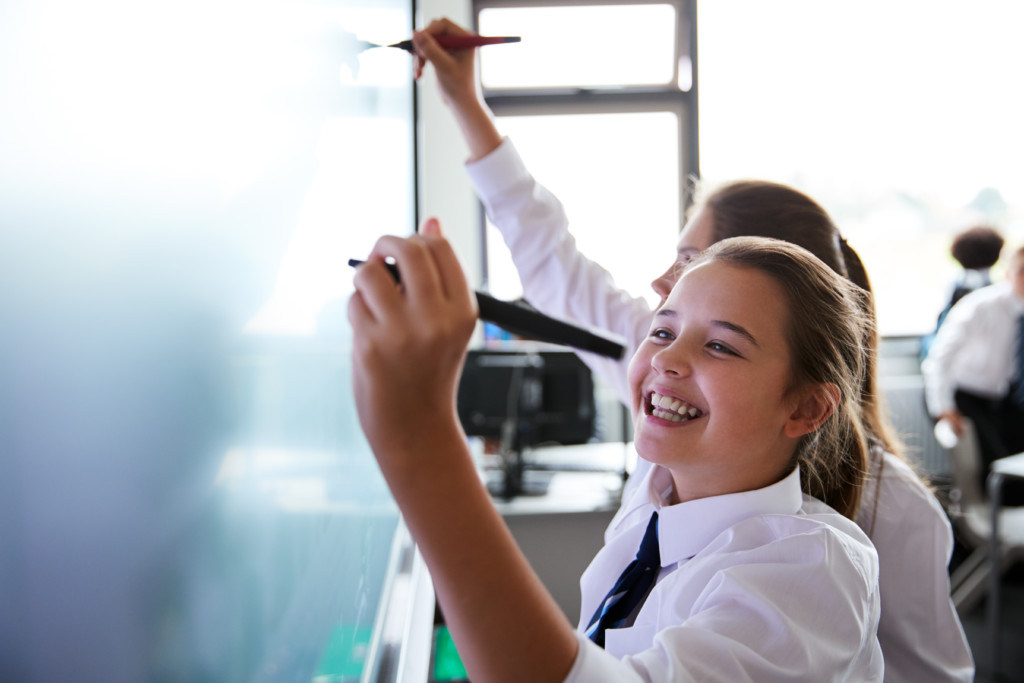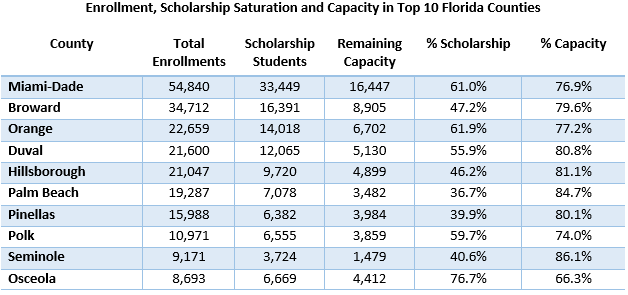 Florida’s private schools may reach full enrollment capacity in as little as three years according to data from a survey conducted by Step Up For Students, a state-approved nonprofit scholarship funding organization that helps administer four scholarships for Florida schoolchildren.
Florida’s private schools may reach full enrollment capacity in as little as three years according to data from a survey conducted by Step Up For Students, a state-approved nonprofit scholarship funding organization that helps administer four scholarships for Florida schoolchildren.
Fortunately, hundreds of schools are preparing to grow, and as a special report compiled by
Step Up For Students and EdChoice researchers shows, teachers and innovators are bringing new educational options to the market.
The survey reports that private schools are operating at 79% capacity with room for an additional 84,442 students. At current scholarship growth rates, that number could be reached in 3 to 5 years if those schools do not expand capacity.
The survey ran from Aug. 17-22 and included 2,042 schools, which reporting a total enrollment of 314,246students. Of that number, 167,682 (53.4%) participated in the Florida Tax Credit Scholarship program or the Family Empowerment Scholarship for Educational Options program.
According to the survey, the average participating private school serves 155 students; an average of 83 students attend on a scholarship. The average school has room to add another 41 students.

The scholarship saturation rate (the number of scholarship students as a percentage of all private school students) varied from a low of 18.6% Walton County to 100% in Sumter and Union counties. Counties with the most room for private school enrollment growth included Union County (at 35% of total capacity), Hamilton (49.6%), Baker (51.6%) and Holmes (52%).
These counties also tended to have some of the lowest total enrollment and smallest private schools in the state.
Counties with the least room for growth included Hardee (98.3%), Walton (95.2%), Citrus (90.7%) and Alachua (90.7%).

Breaking schools down by religious affiliation, Islamic/Muslim schools had the highest scholarship saturation rate, while Catholic schools had the lowest. Schools reporting their religious affiliation as “other,” or which did not report an affiliation, had the most remaining capacity, while Jewish and Catholic schools had the least room for growth.
Catholic schools had the largest average enrollment (399 students) and largest average scholarship enrollment (173), but lowest saturation rate (43.4%). Schools listed as “other” or not reporting a religious affiliation had the lowest average enrollment (89) and fewest scholarship students (42).
Islamic schools had the largest room for growth with an average of 65 additional students per school. Jewish schools reported the least room for growth with an average of 36 additional students per school.
The enrollment survey asked schools seven additional questions regarding each one’s ability to enroll more students in the future. Of the 2,042 participating private schools responding to the survey, 1,806 provided responses on school capacity.
Here are the questions and answers:
Q. Is your school reaching full capacity or already over capacity for student enrollment?
615 schools (34.1%) said Yes
Q. If you have room available for enrollment growth, is your school willing to accept additional scholarship students?
1,704 schools (94.4%) said Yes
Q. Do you have a waitlist to attend your school?
501 schools (27.7%) said Yes
Q. Follow up question: If so, how many students are on your waitlist?
482 schools reported having an average waitlist of 21 students, or 10,156 students total
Q. Do you plan on expanding to add additional seats next year?
1,016 schools (56.3%) said Yes.
Q. How many students do you wish to add next year?
810 schools reported wishing to add an average of 50 new students next year, or 40,877 students total
Q. What, if anything, is prohibiting your school from growing? (Schools could choose more than one option)
Lack of facilities on the property: 615 schools (34.1%)
Difficulty hiring new teachers: 609 schools (33.7%)
Lack of capital funding: 591 schools (32.7%)
No space on existing property to expand: 468 schools (25.9%)
Nothing yet, we still have plenty of room to grow: 372 schools (20.6%)
Lack of transportation options for new students: 276 schools (15.3%)
Poor local awareness or insufficient advertising: 198 schools (11.0%)
We wish to remain small or keep our current size: 175 schools (9.7%)
We are concerned expansion may negatively impact education quality: 129 schools (7.1%)
Other: 95 schools (5.3 percent).
Step Up For Students, which hosts this blog, serves more than 241,000 students across the state with the five scholarship programs it administers. Of those students, more than 180,000 students use the Florida Tax Credit Scholarship or Family Empowerment Scholarship for Educational Options to attend one of 2,073 private schools.



[…] This article originally appeared at reimaginED. […]